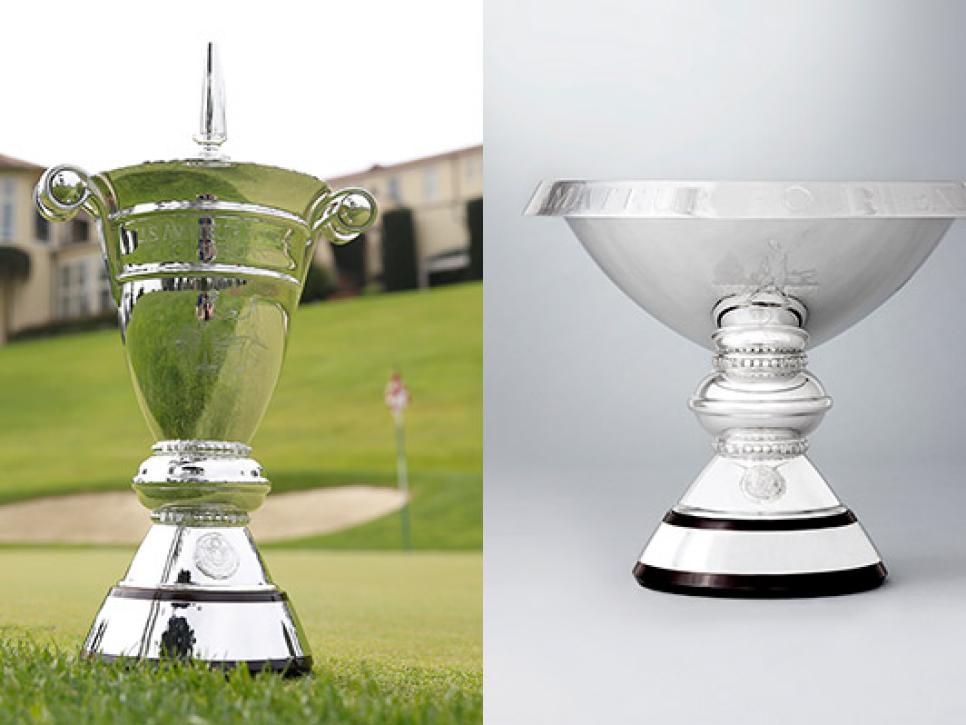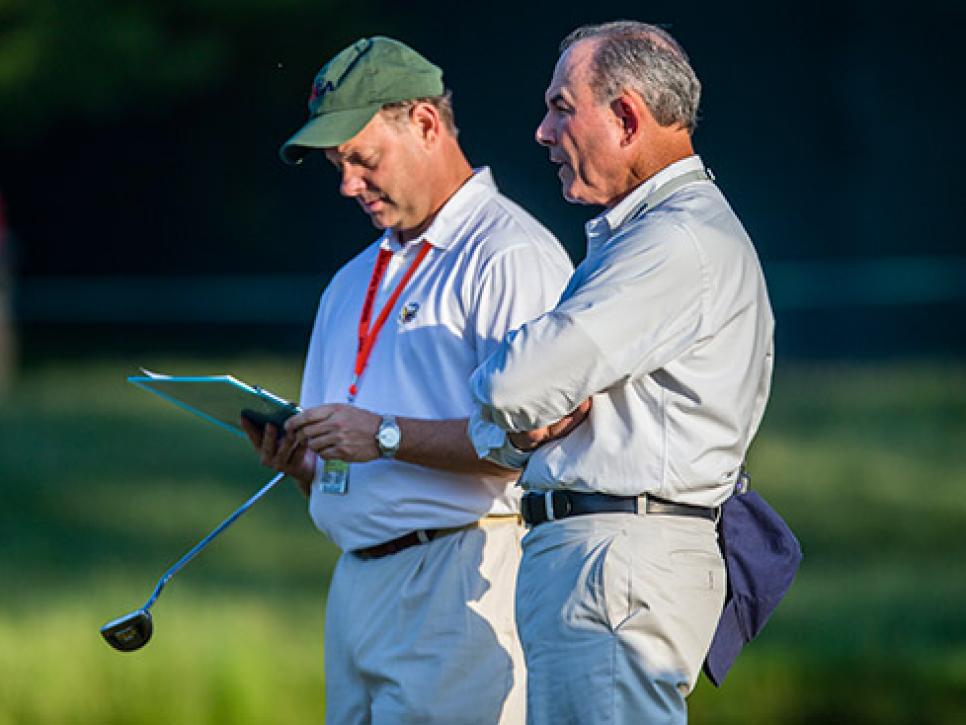News
A Team Effort

English silversmith Nicholas Winton designed the men's and women's Four-Ball trophies, the first commissioned by the USGA since 1948.
On most weekend mornings on most golf courses in the United States, it is the way play begins. Someone says, “What’s the match?” and either two old friends team up against two longtime foes, or four balls are tossed into the air, with the two landing closest to each other becoming partners for the day. Then the haggling for strokes begins.
Four-ball. Better-ball. Or the grammatically incorrect but more commonly used best-ball. It’s the way millions of Americans play golf. The better score on each hole from our two balls against the better of your two.
And now the USGA has two national championships using America’s most popular format. The U.S. Amateur Four-Ball Championship and the U.S. Women’s Amateur Four-Ball Championship debut the next two weeks, and even before the first finals the new events are an unqualified success.
So far.
“So far is the operative word,” says John Bodenhamer, USGA senior managing director of Rules, Competitions & Equipment Standards. “We are tremendously satisfied from every measuring stick—number of participants, quality of venues and handling the logistics. So far these two events have exceeded our wildest expectations.”
In an unprecedented seven-month process from last August through March, qualifying for the men’s Four-Ball was conducted at 51 sites. The response was overwhelming: 4,468 entries (2,234 teams), making it the third-largest USGA championship behind the U.S. Open and the U.S. Amateur. To enter, men need a Handicap Index not exceeding 5.4.
The finals are May 2-6 using both the Lake and Ocean courses at the Olympic Club in San Francisco, a host to nine USGA championships, including five U.S. Opens. The 128 teams in the finals play 36 holes of stroke play, counting the better score of the two players on each hole to determine the 32 teams that advance to match play.
The women’s Four-Ball used 28 qualifying sites to vet 672 players (336 teams). It’s the fourth-largest USGA women’s championship, behind the U.S. Women’s Open, the U.S. Women’s Amateur and the U.S. Girls’ Junior.
The Women’s Four-Ball is May 9-13 on the Pacific Dunes course at Oregon’s Bandon Dunes Resort. Sixty-four teams play 36 holes of stroke play to determine the 32 sides for match play. The Handicap Index cutoff for women was 14.4.
The semifinals and finals for both the men and women will be televised by FOX Sports 1 as part of the 12-year, $1.1 billion contract the USGA has with FOX that begins this year.

John Bodenhamer (right) credits USGA executive director Mike Davis with being the catalyst in making the Four-Ball Championships a reality. (Photo: USGA/Joel Kowsky)
According to Bodenhamer, the idea of the Four-Ball championships, the first new events from the USGA in 28 years, had been discussed for more than a decade. It wasn’t until four years ago, however, when Mike Davis became USGA executive director, that they began receiving serious consideration.
“These championships represent new thinking in the USGA,” Bodenhamer says. “They were the visions of Mike Davis. He’s been advocating for this for about 15 years. When he took over, he brought it to us as the leadership. Coming from the SRA [state and regional golf associations], I know how popular this format is. It recognizes that four-ball is the most popular format of play across the country.”
The timing—coming on the USGA schedule as the U.S. Amateur Public Links and the U.S. Women’s Amateur Public Links were leaving—was coincidental, Bodenhamer says. The APL and WAPL had morphed into essentially college tournaments no longer representing the grassroots public golfer as originally intended. The Four-Ball championships will clearly better serve that demographic.
“It also allowed us to conduct a championship at a time of the year we haven’t done before, in the spring,” Bodenhamer says. The USGA now has at least one championship each month from May through October, with qualifying for the Four-Ball essentially year round.
With so many qualifying sites, the events could not have been implemented without help from the state and regional golf associations. It turned out to be a win-win for both the USGA and the SRAs. The USGA gets two national championships that speak to the soul of American golfers. And the SRAs get another tool to help grow the game.
“The SRAs all conduct four-ball championships,” Bodenhamer says. “There was a strong foundation in the SRAs, and that made it obvious this was the way the game was going. It’s a very exciting format that promotes risk and reward, consistent with the new USGA under Mike that favors drivable par 4s and reachable par 5s—exciting golf.”
Among the challenges for the USGA was how to handle withdrawals and injuries. A small window was created to allow for substitutions, but firm cutoff dates also had to be set. The first year produced one fascinating situation. Bill Walbert, a 47-year-old physician’s assistant, was called into surgery last November on the day he was to try to qualify. His partner, 18-year-old Brent Grant, showed up with a substitute but was told the deadline had passed. All Grant did was shoot nine-under 63 on his own ball at Honolulu C.C. to advance to the finals.
“This is a great example of the application of Rule 31-2, which states, ‘A side may be represented by either partner for all or any part of a stipulated round, both partners need not be present,’ ” says Bill McCarthy, the USGA’s director of competition of the men’s Four-Ball. “Regardless of the fact that Mr. Walbert was not present to assist his partner, the side has earned a spot in the championship, and that includes Mr. Walbert.”
The new trophies for the men’s and women’s Four-Ball were the first pieces of hardware the USGA had had to commission since 1948. Designed by English silversmith Nicholas Winton, the silver cup sits on a base that features a four-balls-and-four-clubs motif.
Pacific Dunes will measure 6,003 yards and play to par 72 for the women’s Four-Ball, says Rachel Graves, the USGA director of competition for the event. “For many of the players, it will be the most-challenging, yet fair, test of golf they will see all year,” Graves says. “The course can be intimidating given the winds, tight lies and the need for good course strategy.”
The Olympic Club’s Lake Course will be set up at 6,981 yards at par 70 for the men. The Ocean Course, which will serve as the companion course for the two days of stroke-play qualifying, will be 6,761 yards and par 70.
The way the golf community has embraced the Four-Ball is impressive. Next year, highly acclaimed Streamsong Resort in central Florida will host the women’s championship with the 2017 event going to The Dunes Golf and Beach Club in Myrtle Beach. In 2016, the men play New York’s Winged Foot G.C., with the Pinehurst (N.C.) Resort hosting in 2017 and Jupiter Hills in Tequesta, Fla., in 2018.
“Americans play in groups of four,” Bodenhamer says. “The nassau at the club, who doesn’t do that? We think [these championships are] going to inspire more people to play the game.”
And now, the way America plays the game has its own national championship.